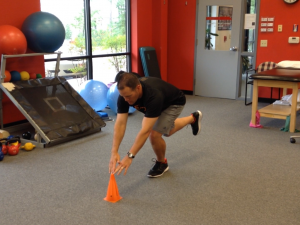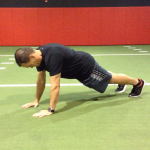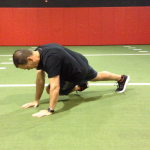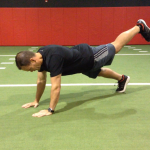Brian Schiff’s Blog
Injury Prevention, Sports Rehab & Performance Training Expert
Improving proximal hip stability and reducing frontal plane collapse is critical for protecting the knee. Poor frontal plane control often contributes to anterior knee pain, IT band syndrome, shin splints, plantar fasciitis and other injuries. This exercise is an advance progression of the standing pallof press, and it is very effective for enhancing single leg strength as well as hip/core stability.
Click here to read my full column on this exercise in PFP Magazine.
Whether doing prehab, rehab or training, I believe in using single leg exercises to attack asymmetries, imbalances and motor deficits I uncover in my assessments. Learning to control one’s body in space with the effect of gravity in a weight bearing position is instrumental for sport and injury prevention.
Furthermore, facilitating ankle mobility and proper knee alignment during a loaded squat pattern is something most athletes and clientele I work with need some help with. to that end, I utilize several different single leg reaching progressions and exercises. One of my favorite ‘go to’ exercises is the anterior cone reach.
I recently featured this specific exercise in my ‘Functionally Fit’ column for PFP Magazine. Click here to see the video demonstration.
This is a great exercise with progressions and regressions for clients of all ages and abilities.
Increasing shoulder, torso and hip strength and stability is a common training goal for athletes involved in sport. Facilitating hip disassociation and kinetic chain linking with exercise is always a plus. I like to use a diagonal mountain climber with hip extension to accomplish these objectives. More specifically, I utilize this exercise with my overhead athletes and anyone involved in cutting, pivoting and rotational sports.
Begin in a tall plank position. The hands should be beneath the shoulders with the feet on the floor and shoulder width apart. Slowly bring the left knee/hip under the body and toward the right elbow. Pause at the end point prior to losing form or control.
Next, return the left leg toward the start position and up into full hip extension in one continuous movement. Pause at the top end of available hip extension and repeat the cycle for 10 repetitions or time on the same leg. Alternate legs and perform 2-3 sets on each side.
Sufficient upper body strength and core/hip stability in a 3 point position is necessary to perform the exercise correctly. At no time should the foot of the moving leg touch the floor or be used to balance the body. As far as a pace, I feel using a 1/1/1/1 cadence works best.
This exercise is an excellent way to promote shoulder, core and hip stability while facilitating hip disassociation as well. Driving the hip back up into extension will activate the gluteals and simultaneously force the stable (fixed) hip to stabilize the pelvis and counterbalance the movement pattern. In addition, the client will have to effectively activate the hip and abdominal musculature throughout to avoid unwanted pelvic tilt/rotation during the movement.
Click here to view the full video of this exercise I did for my ‘Functionally Fit’ column for PFP Magazine.
All effective prehab and rehab programs for recreational and competitive athletes should include single leg stability exercises. I like to use sliding exercises as one way to improve neuromuscular control of the core, hip and knee. Frontal plane collapse is a common issue with respect to knee dysfunction. Using sliders/gliding discs as well as theraband is an excellent way to improve strength and kinetic chain control. Below is an exercise i recently featured for Personal Fitness Professional:
This exercise is effective in injury prevention and rehab programs for those with ankle instability, anterior knee pain, hip weakness, poor landing mechanics and higher ACL risk if playing pivoting and cutting sports. It will improve core stability, hip and knee strength/stability, dynamic balance, groin flexibility and trunk control.
The band serves to enhance activation of the hip external rotators and further challenge stability of the hip and knee. The band should not pull too forcefully, but just enough to cue the desired muscle activation pattern. A slower cadence on the eccentric portion of the exercise is preferable to maximize stability and strength gains. Do not force through any painful ranges of motion, and remember that form and alignment are paramount so limit the reaching based on the client’s ability to maintain adequate control.
Facilitating better lower leg stability is always a priority in my rehab and training programs. I have long been an advocate of single leg training to resolve asymmetry and reduce compensations and injury risk. Once a client masters form on the ground, adding in more proprioceptive challenges can take their training to a new level.
Today I wanted to share a previously unpublished video I shot for my ‘Functionally Fit’ column that demonstrates a single leg squat exercise on the BOSU Elite Trainer. It is a relatively new exercise tool that offers some tweaks on the original BOSU balance trainer.





